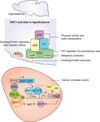SIRT1 and other sirtuins in metabolism
- PMID: 24388149
- PMCID: PMC3943707
- DOI: 10.1016/j.tem.2013.12.001
SIRT1 and other sirtuins in metabolism
Abstract
Sirtuins such as SIRT1 are conserved protein NAD(+)-dependent deacylases and thus their function is intrinsically linked to cellular metabolism. Over the past two decades, accumulating evidence has indicated that sirtuins are not only important energy status sensors but also protect cells against metabolic stresses. Sirtuins regulate the aging process and are themselves regulated by diet and environmental stress. The versatile functions of sirtuins including, more specifically, SIRT1 are supported by their diverse cellular location allowing cells to sense changes in energy levels in the nucleus, cytoplasm, and mitochondrion. SIRT1 plays a critical role in metabolic health by deacetylating many target proteins in numerous tissues, including liver, muscle, adipose tissue, heart, and endothelium. This sirtuin also exerts important systemic effects via the hypothalamus. This review will cover these topics and suggest that strategies to maintain sirtuin activity may be on the horizon to forestall diseases of aging.
Keywords: CR mimetics; NAD(+); SIRT1; aging; calorie restriction; metabolism; sirtuins.
Copyright © 2013 Elsevier Ltd. All rights reserved.
Figures


References
-
- Imai S, Armstrong CM, Kaeberlein M, Guarente L. Transcriptional silencing and longevity protein sir2 is an nad-dependent histone deacetylase. Nature. 2000;403(6771):795–800. - PubMed
-
- Sinclair DA, Guarente L. Extrachromosomal rdna circles--a cause of aging in yeast. Cell. 1997;91(7):1033–1042. - PubMed
-
- Tissenbaum HA, Guarente L. Increased dosage of a sir-2 gene extends lifespan in caenorhabditis elegans. Nature. 2001;410(6825):227–230. - PubMed
Publication types
MeSH terms
Substances
Grants and funding
LinkOut - more resources
Full Text Sources
Other Literature Sources
Miscellaneous

